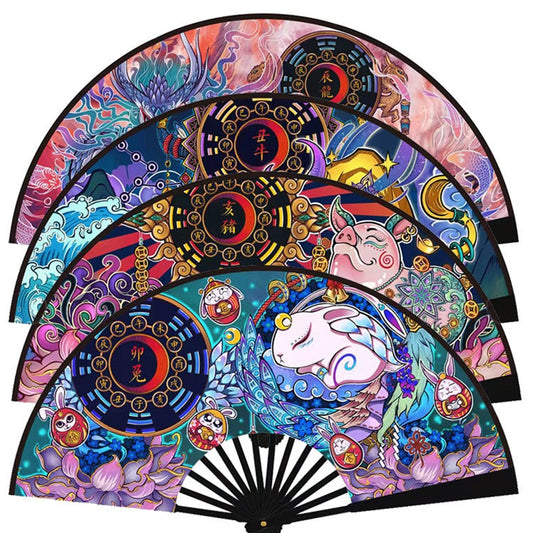Chi Lins are mythical animals that symbolize wisdom, prosperity, good luck, and longevity in Chinese culture. They are also known by other names, such as Kirin in Japan, or Dragon Horse or Chinese Unicorn in English. Chi Lins have the head of a dragon, the body of a deer or horse, the tail of an ox, and the scales of a carp. They are often depicted with one or more horns, sometimes covered with fur. Chi Lins are said to be virtuous, kind, and vegetarian. They can walk on both land and water, and they never touch their hoofs on the ground to avoid harming any living beings.
Chi Lins are considered to be one of the four supernatural creatures in Chinese mythology, along with the Dragon, the Phoenix, and the Tortoise. They are also one of the eight Taoist symbols of good fortune. Chi Lins are believed to appear as a positive omen when a great ruler or wise sage is born or dies. They are also thought to carry the writings of great wisdoms on their backs or in their mouths.
History and Legend of Chi Lins
The earliest mention of Chi Lins can be traced back to the ancient Chinese book “Shan Hai Jing” (Classic of Mountains and Seas), which describes various mythical creatures and geography. Chi Lins are described as having five colors: red, white, blue, yellow, and black. They are also said to have five toes on each foot, which is a sign of nobility in Chinese culture.

One of the most famous stories involving Chi Lins is related to Confucius, the great philosopher and teacher. According to legend, when Confucius’ mother was pregnant with him, she dreamed of a Chi Lin presenting her with a piece of jade that had his name engraved on it. This was seen as a sign that her son would become a great sage and leader. Another legend says that when Confucius was born, a phoenix appeared in the sky and a Chi Lin roamed on the hills nearby.
Another story says that when Confucius was an old man, he saw a wounded stag that he recognized as a Chi Lin. He realized that this was a bad omen for his life and his teachings. He cried and said: “My principles have no followers; even this beast does not escape calamity.” He died soon after.

Feng Shui Applications for Chi Lins
Chi Lins are often used as feng shui cures to attract wealth, success, harmony, and descendants luck. They can be found in various forms of art and decoration, such as ceramics, wood carvings, bronze statues, embroideries, paintings, etc. Chi Lins can be placed in different areas of the home or office depending on the desired effect.
Front Entry
A pair of Chi Lins can be placed on each side of the main entrance to protect the house from negative energies and harmful people or events. They can also welcome good luck and prosperity into the home.
Desk or Workspace
A single Chi Lin can be placed on the desk or in the office space to bring career success and good fortune. It can also enhance creativity and intelligence.
Bedroom
A pair of Chi Lins can be placed in the bedroom to enhance marital harmony and fertility luck. They can also ward off any third parties or relationship problems.
Children’s Room
A single Chi Lin can be placed in the children’s room to bless them with good health, academic excellence, and moral values.

Wealth Corner
A single or pair of Chi Lins can be placed in the wealth corner (southeast) of the home or office to attract abundance and prosperity. They can also be combined with other auspicious symbols such as coins or ingots.
How to Choose and Care for Chi Lins
When choosing a Chi Lin for feng shui purposes, there are some factors to consider:
- The material: Chi Lins can be made of different materials such as metal, wood, ceramic, stone, etc. Each material has its own properties and associations with different elements. For example, metal represents metal element and can activate wealth luck; wood represents wood element and can activate growth luck; ceramic represents earth element and can activate stability luck; stone represents earth element and can activate protection luck; etc.
- The color: Chi Lins can also have different colors such as gold, silver, bronze, white, black, etc. Each color has its own meaning and effect on the energy of the space. For example, gold represents wealth and prosperity; silver represents elegance and refinement; bronze represents power and authority; white represents purity and peace; black represents mystery and protection; etc.
- The number: Chi Lins can be displayed as a single or a pair. A single Chi Lin can represent individual success and achievement; a pair of Chi Lins can represent partnership and harmony.
- The direction: Chi Lins can be placed facing different directions depending on the intention. For example, facing the door can welcome good luck and opportunities; facing the window can ward off negative influences and dangers; facing the wealth corner can activate abundance and prosperity; facing the personal direction can enhance personal luck and well-being; etc.
When caring for a Chi Lin, it is important to keep it clean and dust-free. It is also advisable to avoid placing it in areas where it can be damaged or broken. It is also respectful to acknowledge and appreciate the Chi Lin for its blessings and protection.
Final Thoughts
Chi Lins are powerful and auspicious animals that can bring many benefits to those who honor and display them. They are symbols of wisdom, prosperity, good luck, and longevity. They are also protectors of harmony, peace, and virtue. By understanding their history, legend, and feng shui applications, one can choose and care for a Chi Lin that suits one’s needs and preferences.









